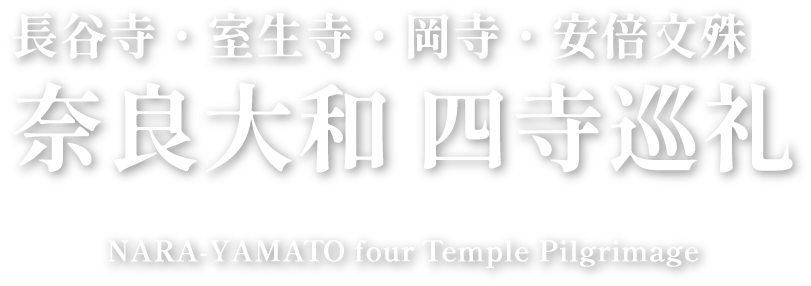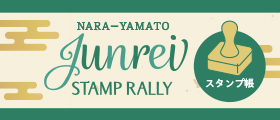NARA-YAMATO Four
Temple Pilgrimage
The Nara-Yamato Four Temple Pilgrimage symbolizes all that is best about Japan. We offer the true and authentic spirit of Japan and welcome you.
Let us bring peace and tranquility to your hearts in the pilgrimage.
You will set on a journey to visit Hase-dera Temple, Muro-ji Temple, Oka-dera Temple and Abe-Monjyuin Temple all of which are magnificent temples located in the Nara-Yamato province. The area called the “Center of the Nation” is the birthplace of imperial rule and is rich in historical sites.
From pretty temples with beautiful gardens and masterpieces of Buddhist sculptures to hidden gems waiting to be explored, the awe-inspiring journey will stay with you forever.
Your heart will discover the true essence of Japan in Nara-Yamato.
“NARA YAMATO Four Temple Pilgrimage”
ultural Assets
Designated by the Minister of Education, Culture, Sports, Science and Technology under the Cultural Assets Preservation Act, Japanese cultural properties, especially National Treasures and Important Cultural Properties, are highly valuable cultural assets.
Tangible cultural properties of particular importance are designated as Important Cultural Properties, and those of particular value from the perspective of world culture are designated as National Treasures.
Cultural properties are valuable national assets that have been created and nurtured over the course of Japan's long history and have been preserved and handed down over the generations until today.
Cultural property includes shrines and temples, Buddhist statues, historic sites and scenic spots, as well as traditional customs and performing arts and natural monuments.
Nara, which is also known by its old name, Yamato, has a profound history that continues to this day.
Many cultural assets were created in the course of its long history and have been handed down to the present day through the efforts of our predecessors.
The four temples also have a number of cultural assets that have been designated as National Treasures and Important Cultural Properties. These historical treasures always remind us of the history and culture of our country.
-
Hase-dera Temple
The Buddha of Compassion
As the head temple of the Buzan School of Shingon Buddhism, Hasedera Temple is the origin of the many “Hasedera Temples” that exist throughout Japan. This magnificent temple also has 3,000 branch temples.
The area, Hase, has been a sacred place since ancient times and appeared in Japanese classical literatures such as the Tale of Genji and the Man’yoshu, or the Collection of a Myriad Leaves.
The temple is known as the 8th temple of the 33 Saikoku Kannon Pilgrimage in the western part of Japan.
Hasedera Temple is also well known as the “Flower Temple” as the temple grounds are decorated with flowers throughout the four seasons which delight many pilgrims.
During the Special Opening periods, visitors can enter the main hall, a National Treasure, and directly touch the foot of the Kannon (Goddess of Mercy).Learn More
-
Muro-ji Temple
The Buddha of Enlightenment
Muroji Temple has mercifully accepted women even at a time when many temples did not allow women to enter.
While Koyasan strictly forbade women, Muroji Temple is widely known as "Nyonin Koya," or "Mt. Koya for Women," and has long been revered as a sacred place of dragon god worship, deep in the mountains with clear streams flowing through it.
The main image of Shakyamuni Buddha in the main hall is made of wood.
The crest of his robe has the characteristics of the Honpa style pattern of the early Heian period.
The pattern which looks powerful, yet delicate and flowing in its own unique style is called Muroji-sama.Learn More
-
Oka-dera Temple
The Buddha of Wish-Granting
The temple was founded in 663. The original name of the temple was Ryugaiji, but since ancient times it has been affectionately called “Oka-dera,” meaning "temple on the hill in Asuka village".
The main deity, Nyoirin Kannon, is the largest statue made of clay in Japan and was built in the Nara period. The temple is the 7th temple of the 33 Saikoku Kannon Pilgrimage in the western part of Japan.
It is also the first sacred place in Japan for expelling of bad luck, therefore, is visited by many people from all over Japan to pray for the fulfillment of their wishes.Learn More
-
Abe-Monjuin Temple
The Buddha of Wisdom
Abe Monjuin Temple, founded in 645, is one of the oldest Buddhist temples in Japan.
The main deity of Abe Monjuin Temple is Monju Bosatsu, who is also famous for the saying, “When three people gather, Monju's wisdom comes with them.” The statue of Tokai Monju, accompanied by four assistants, was built by Buddhist monk Kaikei during the Kamakura period.
The statue represents a scene of his embarking on a journey of preaching to dispel the demons of sentient beings and to bestow wisdom.
It is designated as a National Treasure.
The temple is widely known as a sacred place of Monju worship where many people from children to adults visit to receive wisdom.
It is also a temple associated with Abe Seimei, and is believed by many to be a sacred place to ward off evil spirits and prevent calamities.Learn More




